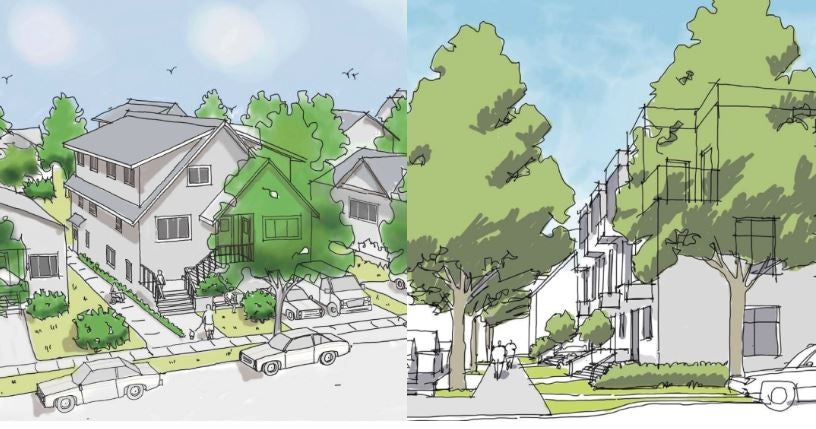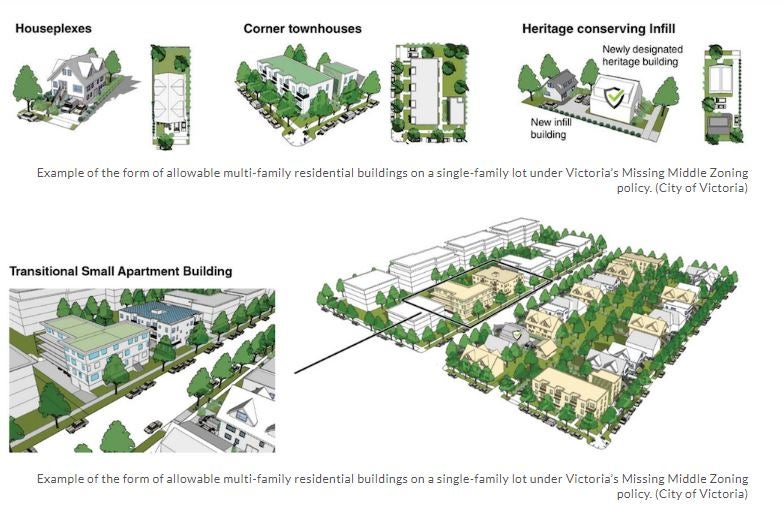
Single-family zoning across British Columbia communities will come to an end as early as before the end of 2023, when the provincial government is expected to introduce legislation that overrides the zoning regulations of municipal governments.
Premier David Eby and BC minister of housing Ravi Kahlon made the announcement on Monday, as part of the provincial government’s ambitious new multi-faceted Homes For People action plan.
While the plan is supported by billions of dollars in new housing-related investments over the coming years, it also includes major policy changes to simply catalyze more housing, but with a focus on gentle densification in existing low-density neighbourhoods.
The legislation changes would allow up to four homes on a traditional single-family lot in municipalities across the province. This enables homeowners to create secondary suites, such as basement units or potentially even duplexes, townhomes, and triplexes. On Tuesday, during the Union of British Columbia Municipalities’ (UBCM) convention on housing, Kahlon reiterated the immense potential for this program to create thousands of new additional homes across the province, especially where secondary suites are currently not allowed.
“Right now, outdated zoning laws in many communities mean most can only construct high-rise condo towers or ask young families to purchase single-family homes as their first home. While these types of homes work for some and will remain an important fabric of our community, the reality is for most, these types of housing units do not meet their needs and are simply out of reach,” said Kahlon at the UBCM event on Tuesday.“
This means there are too many neighbourhoods where we are losing family and children, and losing that important feeling of community. Grandparents who want their children and grandchildren nearby, young families and young people pleading for housing options within reach and not a distant dream, and businesses asking where all the workers have moved to."
Not only would there be a policy change to allow secondary suites, but homeowners would be incentivized to do so. Starting in early 2024, accompanied by the legislation changes, the provincial government will create a new loan program for homeowners to cover 50% of the cost of renovations associated with adding secondary suites — up to a maximum of $40,000 over five years. And as a housing affordability measure, homeowners will have their loan forgiven if they meet conditions, including renting the unit at below-market rates for at least five years.
“Without more types of homes, we risk pushing more of our future generation away. We risk creating neighbourhoods where playgrounds are quiet, sidewalks are empty, and coffee shops are vacant. Small-scale, multi-unit homes are how we address this challenge,” said Kahlon
He notes that they have commenced discussions with municipal governments to fine tune this so-called Small-Scale Multi-Unit Housing strategy. At least one secondary suite will be permitted in all traditional single-family zones. But in select communities, there will be a minimum number of homes per lot on single-family zones. And in another set of select communities, the provincial government will mandate a minimum number of homes per lot on single-family zones near frequent public transit services.
Large jurisdictional top-down changes are not unprecedented, as New Zealand also made a similar move in 2021, when it enacted legislation that required local governments to allow property homes to build up to three units up to three storeys on most types of single-family lots.
The City of Vancouver is already looking into allowing up to six units for all single-family neighbourhoods, including the potential for multiplexes, with public consultation on the policy changes well underway. This would add to Vancouver’s regulations allowing a basement suite and a laneway house, which were first permitted in 2009.
To achieve up to six units, City of Vancouver staff have limited their proposed floor area ratio density (FAR) density increase for each single-family lot to no more than 1.0 FAR, which means the total usable floor area inside the buildings on a lot can reach up to the same land area size of the lot — an increase from the existing limitations of 0.86 FAR for a main house and laneway house with three units on a single-family lot, 0.7 FAR for a duplex and suites with four units, and 0.85 FAR for a multiplex and infill with six units.

To achieve up to six units, City of Vancouver staff have limited their proposed floor area ratio density (FAR) density increase for each single-family lot to no more than 1.0 FAR, which means the total usable floor area inside the buildings on a lot can reach up to the same land area size of the lot — an increase from the existing limitations of 0.86 FAR for a main house and laneway house with three units on a single-family lot, 0.7 FAR for a duplex and suites with four units, and 0.85 FAR for a multiplex and infill with six units.
Some critics have suggested a relatively low density increase to 1.0 FAR may not make the projects viable. But City of Vancouver staff previously expressed weariness with allowing greater density beyond 1.0 FAR in single-family neighbourhoods due to the constraints of sewer capacity, and the associated high costs with providing a major upgrade of the utilities.
A variation of Vancouver’s proposed policy already exists in the City of Victoria, which approved its Missing Middle Housing policy in January 2023. Victoria’s policy has effectively ended single-family zoning, allowing up to six units on mid-block lots and 12 units on corner lots — all without the need to pursue rezoning.
Victoria’s policy enables corner townhomes and infill housing on lots with an existing home that carries heritage merit. City of Victoria officials presenting at UBCM shared that they had to be more creative with the building form their policy changes would support. For example, as much of Victoria lacks laneways, the type of laneway house typology that exists in Vancouver would generally not be possible in many instances.
Victoria’s base single-family lot density is now 0.5 FAR, and a bonus density of 1.1 FAR is now permitted, as long as properties provide a dedicated right-of-way and at least one public benefit. The options for the provision of a public benefit are a cash contribution to the municipal government, below-market home ownership units, a secured rental housing project, an affordable rental housing component, co-op housing, or heritage designation.

There are also already examples of how gentle densification can be applied to even smaller communities. The City of Kimberley, a community in the southeast corner of BC with about 8,000 people, has a minimum density policy of two units per lot in one single-family residential zone, up to six units in its R2-zone, and up to 10 units if 25% of the units are set aside as affordable rentals.
As for helping to ensure these Small-Scale Multi-Unit Housing units are realized, the provincial government will work with municipal governments to simplify and speed up their permitting process, with a focus on expanding digital tools.
There are many cogs and gears to the provincial government’s broad strategy to tackle housing affordability and supply. As previously announced, the new Housing Supply Act will enable the provincial government to set annual housing supply approval targets for municipal governments to meet.
This act will be applied on municipalities with the highest demand and projected growth. Transit-oriented development will also be a major focus for the provincial government, which has set aside about $400 million over the next three years to buy land next to public transit. Kahlon says the Homes For All action plan will use this funding to help deliver up to 10,000 homes at or near major public transit hubs over the next 10 to 15 years.